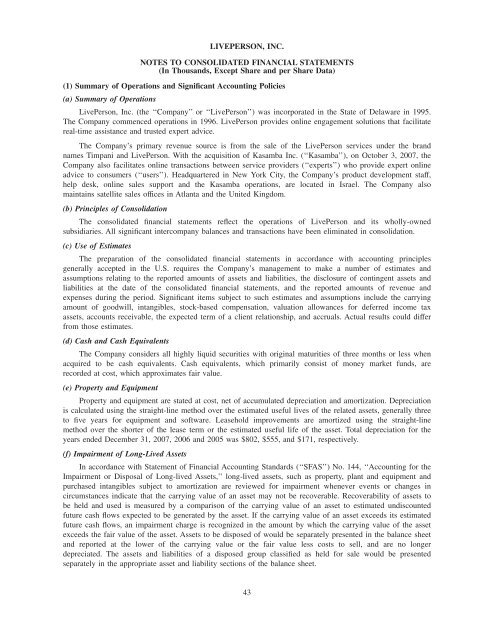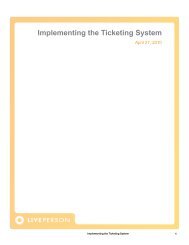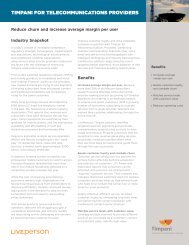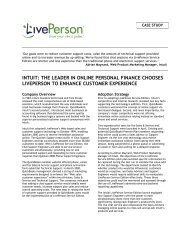Annual Report 2007 - LivePerson
Annual Report 2007 - LivePerson
Annual Report 2007 - LivePerson
You also want an ePaper? Increase the reach of your titles
YUMPU automatically turns print PDFs into web optimized ePapers that Google loves.
LIVEPERSON, INC.<br />
NOTES TO CONSOLIDATED FINANCIAL STATEMENTS<br />
(In Thousands, Except Share and per Share Data)<br />
(1) Summary of Operations and Significant Accounting Policies<br />
(a) Summary of Operations<br />
<strong>LivePerson</strong>, Inc. (the ‘‘Company’’ or ‘‘<strong>LivePerson</strong>’’) was incorporated in the State of Delaware in 1995.<br />
The Company commenced operations in 1996. <strong>LivePerson</strong> provides online engagement solutions that facilitate<br />
real-time assistance and trusted expert advice.<br />
The Company’s primary revenue source is from the sale of the <strong>LivePerson</strong> services under the brand<br />
names Timpani and <strong>LivePerson</strong>. With the acquisition of Kasamba Inc. (‘‘Kasamba’’), on October 3, <strong>2007</strong>, the<br />
Company also facilitates online transactions between service providers (‘‘experts’’) who provide expert online<br />
advice to consumers (‘‘users’’). Headquartered in New York City, the Company’s product development staff,<br />
help desk, online sales support and the Kasamba operations, are located in Israel. The Company also<br />
maintains satellite sales offices in Atlanta and the United Kingdom.<br />
(b) Principles of Consolidation<br />
The consolidated financial statements reflect the operations of <strong>LivePerson</strong> and its wholly-owned<br />
subsidiaries. All significant intercompany balances and transactions have been eliminated in consolidation.<br />
(c) Use of Estimates<br />
The preparation of the consolidated financial statements in accordance with accounting principles<br />
generally accepted in the U.S. requires the Company’s management to make a number of estimates and<br />
assumptions relating to the reported amounts of assets and liabilities, the disclosure of contingent assets and<br />
liabilities at the date of the consolidated financial statements, and the reported amounts of revenue and<br />
expenses during the period. Significant items subject to such estimates and assumptions include the carrying<br />
amount of goodwill, intangibles, stock-based compensation, valuation allowances for deferred income tax<br />
assets, accounts receivable, the expected term of a client relationship, and accruals. Actual results could differ<br />
from those estimates.<br />
(d) Cash and Cash Equivalents<br />
The Company considers all highly liquid securities with original maturities of three months or less when<br />
acquired to be cash equivalents. Cash equivalents, which primarily consist of money market funds, are<br />
recorded at cost, which approximates fair value.<br />
(e) Property and Equipment<br />
Property and equipment are stated at cost, net of accumulated depreciation and amortization. Depreciation<br />
is calculated using the straight-line method over the estimated useful lives of the related assets, generally three<br />
to five years for equipment and software. Leasehold improvements are amortized using the straight-line<br />
method over the shorter of the lease term or the estimated useful life of the asset. Total depreciation for the<br />
years ended December 31, <strong>2007</strong>, 2006 and 2005 was $802, $555, and $171, respectively.<br />
(f) Impairment of Long-Lived Assets<br />
In accordance with Statement of Financial Accounting Standards (‘‘SFAS’’) No. 144, ‘‘Accounting for the<br />
Impairment or Disposal of Long-lived Assets,’’ long-lived assets, such as property, plant and equipment and<br />
purchased intangibles subject to amortization are reviewed for impairment whenever events or changes in<br />
circumstances indicate that the carrying value of an asset may not be recoverable. Recoverability of assets to<br />
be held and used is measured by a comparison of the carrying value of an asset to estimated undiscounted<br />
future cash flows expected to be generated by the asset. If the carrying value of an asset exceeds its estimated<br />
future cash flows, an impairment charge is recognized in the amount by which the carrying value of the asset<br />
exceeds the fair value of the asset. Assets to be disposed of would be separately presented in the balance sheet<br />
and reported at the lower of the carrying value or the fair value less costs to sell, and are no longer<br />
depreciated. The assets and liabilities of a disposed group classified as held for sale would be presented<br />
separately in the appropriate asset and liability sections of the balance sheet.<br />
43







